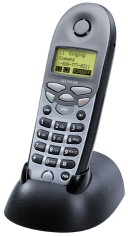| |
|
|
|
|
|
|
By Cheryl Currid
It's been a long journey, and I've subjected the staff here to several strange concoctions of phones, voice mail, base units and other gadgetry. During the search we were so disappointed with other cordless phone systems we tested that we kept going back to our old one, even though the company went out of business two years ago. Our requirements: multiple cordless handsets,
individual voice mailboxes, multiple line coverage, caller ID and a good
range to get through all the glass and concrete of my home office. We
also wanted phones that were smaller and lighter than a brick and had
belt clips.
Now, after testing the Siemens Gigaset 8825 system with Gigaset 8800 cordless handsets, we've found peace, a clear connection and a couple of extra features that make the system a delight to use. This system connects to two telephone lines and supports up to eight cordless handsets. Only the base station needs to connect to the phone lines, then it sends the calls to the cordless handsets. The handsets are fully equipped portable phones. They have the ability to transfer, conference in callers and go hands-free using a plug-in earphone or the built-in speakerphone. For me, the hands-free feature is important. Now I don't have to sit in a contorted position when I'm trying to key notes into my computer while carrying on a conversation. Another handy feature is the phone's ability to verbally announce incoming calls. If a call comes in from a number in the phone's directory system, it will announce your prerecorded message to you. For example, if you were to store my cell phone in your directory, your system could say, "Hurry, it's Cheryl on her cell phone -- she is so impatient," when I called. The base unit contains the digital answering system. You can create up to four mailboxes, each with its own greeting. You can also set up the system to answer only and not take messages, play a special greeting for callers with blocked caller ID information or work as an auto attendant. And most of the answering system features can be controlled from the base station, any handset or a remote call. There's even a remote monitoring capability. It enables you to set up a cordless handset to monitor a specific level of noise in a room. If noise in the room goes above that level, the phone will call another cordless handset in the system. This is great for monitoring a room with a sleeping baby or children playing. A little chatter won't set off the call, but you'll be instantly notified when screaming, kicking or yelling is heard. Best of all, Siemens has done a great job of extending
the range of the remote handsets. It runs at 2.4 gigahertz, which is
becoming a crowded space for cordless local area networks, phones and
other wireless devices.
I tested it in an environment that's hostile to many wireless devices. I was sitting in front of a wireless PC with a wireless mouse all trying to use the same frequency. While this location caused other phones to crackle, the Gigaset 8800 worked just fine. GIGASET 8825, $349, includes base unit and one
additional handset; additional handsets (Gigaset 8800) are about $99
This article originally appeared in the Houston Chronicle, July 04, 2002 Copyright ® 1997-2003, Currid & Company, Inc. The Currid Collection articles are part of a series featured in Hearst Publications. If you are interested in obtaining reprints for this, or any, column published by Currid & Company associates, please contact Webmaster by email at webmaster@currid.com.
|
|
|
|
|
|
|
www.currid.com |
| Copyright 2006 Currid & Company. All rights reserved |
 FINALLY,
after a two-year search, I've found a cordless small-business telephone
system with the right stuff.
FINALLY,
after a two-year search, I've found a cordless small-business telephone
system with the right stuff. 
